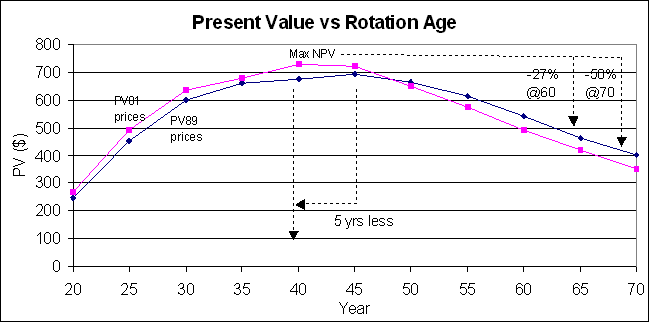 |
 |
 |
 |


|
2002 By Larry Mason Save or Print a PDF copy of Fact Sheet #07
Another manifestation of shifts in log demand is the increased relative value of small diameter saw material. Notice that in 2001 not only did large logs lose premium value compared to 1989 but "chip and saw" increased in value substantially, reflecting a larger demand for this small saw material in 2001. At the same time, however, pulp values dropped significantly as paper making infrastructure in the region declined and world markets in general appeared oversupplied. The objective of this examination, however, is not to declare price absolutes but to better understand how policy driven log shortages over the last twelve years may have caused adjustments in the manufacturing sector that influence forest management decisions and investments. To estimate how price changes influence returns on growing stock
harvested at different rotation ages, a simplified growth simulation
was undertaken for one acre (site index 110) of Douglas-fir planted
to 220/TPA. The forestry software program, the Landscape Management
System (LMS), developed at the University of Washington, was used
in conjunction with the SMC variant of the Organon growth model,
developed at Oregon State University, to "grow" this virtual
forest inventory forward from plantation to 70 years of age. The
charts (figures. 2 & 3.) below display growth as total volume
per acre and as mean and periodic annual increment vs. age. Note
that culmination of periodic annual increment for this growth simulation,
the point at which the annual rate of growth declines, occurs at
age 50.
A series of harvest simulations were applied to each five-year
growth increment. The resulting log volumes were sorted by grade
and size and valued by the adjusted 1989 prices and the 2001 prices.
From these tallies a total gross log value/acre/year for all grades
was calculated for both price scenarios. Total returns/acre for
each time interval and pricing scenario were discounted to a present
value using a 6% expected rate of return. Present values are displayed
for 5 yr. increments in Figure 4. There has long been an historic debate about what harvest age is most desirable. Some tree farmers have argued that final harvest should occur at the culmination of periodic annual increment, in this case age 50. Others argued that if trees were grown past culmination of periodic annual increment that losses in earning potential associated with slowing growth would be compensated by increases in grade and associated price premiums. This is clearly not the case if premium prices are not available for large logs. To the contrary, this simulation could indicate that the market response to log availability changes over the past twelve years has been a price adjustment that rewards landowners managing for shorter rotations. Further, with the 2001 price schedule large log premiums disappear but the "chip and saw" price increases from 54% of a #2 price in 1989 to 82% of a #2 price in 2001. These market adjustments come against a backdrop of landowner complaints of fears that if they grow their trees beyond a certain age or structural condition that governmental restrictions to protect older forests may impose additional harvest constraints in the form of habitat set-asides or widened riparian buffers. It appears that policy changes over the last twelve years, ostensibly designed to protect older forests, may have inspired market responses that are likely to result in management decisions that shorten rather than lengthen harvest rotations on private forestlands in the Douglas-fir zone of the Pacific Northwest. |
||||||||






